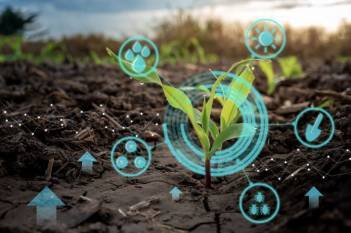MUMBAI, 2 November 2024: As India grapples with unpredictable weather patterns, the nation’s agricultural sector is increasingly vulnerable to climate impacts. Extreme events such as droughts, floods, and prolonged heatwaves now regularly impact crop yields, putting both farmers' incomes and food security at risk.
With agriculture contributing nearly 18% to the country’s GDP and employing over 40% of the workforce, developing climate-resilient practices and crop varieties has become a national priority.
The Urgent Need for Climate-Resilient Crops
Climate change has altered the traditional rhythms of the monsoon, affecting water availability for key crops like rice and wheat. According to a report by the Indian Council of Agricultural Research (ICAR), yields of rainfed rice could drop by as much as 7% to 28%, and wheat by 3% to 5%, without urgent adaptation measures.
To counter these risks, India is investing in crop varieties capable of withstanding harsh conditions, such as drought-tolerant rice and heat-resistant wheat.
ICAR has spearheaded the development of over 1,800 climate-resilient crop varieties, with new strains like DRR Dhan 55, a rice variety suited for saline soils, and Pusa Kranti, a wheat variety resistant to high temperatures. These crops can thrive in extreme environments, helping to stabilize yields despite climatic pressures. Dr. Trilochan Mohapatra, former Director-General of ICAR, stated that such innovations are “crucial to protect the livelihoods of our farmers and the food security of our nation.”
Climate-Resilient Practices: Adapting to New Realities
Alongside crop innovations, practices such as conservation agriculture, agroforestry, and precision farming are being encouraged. Conservation agriculture focuses on minimal soil disturbance, crop rotation, and cover cropping to maintain soil health and retain moisture, making land less susceptible to erosion and degradation during extreme weather events. This approach is gaining traction in drought-prone states like Maharashtra and Rajasthan.
Agroforestry—integrating trees with crops—improves soil fertility, reduces water runoff, and increases biodiversity, making farms more resilient. Studies indicate that agroforestry practices can boost crop productivity by up to 30% on smallholder farms while providing additional income sources through fruits, nuts, or timber.
"With agroforestry, we are not only protecting our crops but also adding another layer of financial stability," says Arvind Verma, a farmer from Madhya Pradesh who has adopted the practice.
Government Initiatives Driving Adaptation
Recognizing the urgency, the Indian government has introduced several initiatives to promote climate-resilient agriculture. The National Innovations in Climate Resilient Agriculture (NICRA) program, launched by ICAR, has been instrumental in researching climate adaptation techniques and creating contingency plans across more than 600 districts. NICRA also supports the development of district-specific practices, ensuring tailored solutions that account for local climatic conditions.
Complementing NICRA is the National Mission for Sustainable Agriculture (NMSA), part of India’s National Action Plan on Climate Change (NAPCC). NMSA’s programs emphasize water-use efficiency, soil health, and sustainable farming practices. Under the Soil Health Card scheme, launched in 2015, farmers receive assessments of their soil quality and recommendations on nutrient management, helping them maintain productivity while reducing dependence on chemical fertilizers.
To boost water efficiency, the government has also rolled out the "Per Drop More Crop" program, which promotes micro-irrigation and other water-saving techniques. "Water is becoming scarcer, and by using it wisely, we’re ensuring our farms survive the next drought season," said Ramesh Gupta, a farmer in Uttar Pradesh who shifted to micro-irrigation with government support..
Technological Advances Supporting Climate Adaptation
Agri-tech startups and collaborations with global technology firms are playing a significant role in climate adaptation. Precision agriculture tools, including drones and IoT sensors, help monitor soil health, crop conditions, and water needs in real-time, enabling farmers to make data-driven decisions. A 2024 report by India’s Ministry of Agriculture highlighted the potential of digital tools to reduce crop losses and enhance resilience by providing timely advisories to farmers during adverse weather.
Further, satellite-based tools developed by ISRO are now used to predict and map potential flood zones, allowing for early warnings and proactive measures. "These tools are revolutionary for farmers who often lose their crops without any warning. Now, they have the time to prepare," remarked Dr. Rajeev Kumar, an agronomist at the Ministry of Agriculture.
Private Sector Engagement in Climate-Resilient Agriculture
Private companies are also stepping up, recognizing the need for sustainable practices in the face of climate uncertainty. Corporations like Bayer, through their Better Life Farming initiative, are working with Indian farmers to promote drought-resistant seeds and sustainable pest management solutions. Similarly, companies like Syngenta have partnered with local governments to develop integrated pest management practices that are less reliant on chemical inputs, helping to preserve soil health and biodiversity.
These collaborations not only support farmers financially but also provide training on climate-smart practices. “Our goal is to build resilience at the grassroots level by empowering farmers with the right tools and knowledge,” said Simon Adams, a spokesperson for Bayer’s agricultural division..
Challenges and the Way Forward
Despite these efforts, several challenges hinder widespread adoption of climate-resilient practices. Smallholder farmers, who constitute the majority of India’s farming population, often lack the financial resources to invest in new technologies and practices. Furthermore, limited awareness of climate-resilient options means many farmers continue traditional practices that may be less effective under current climate conditions.
To address these challenges, increased investment in rural education and training is essential, alongside greater financial support. Expanding access to crop insurance through programs like the Pradhan Mantri Fasal Bima Yojana (PMFBY) is another critical step to help farmers mitigate losses from climate impacts. Since 2016, PMFBY has provided crop insurance to millions, reducing economic strain on farmers facing adverse conditions.
Moving forward, India aims to increase investment in climate-resilient agriculture, with a target of scaling up sustainable practices to cover 60% of farmland by 2030. Experts suggest that integrating sustainable agriculture with national policies on climate action will be essential. Dr. Mohapatra emphasizes, “Our approach must be inclusive, integrating research, field practices, and policy support to safeguard our agricultural future.”
India’s journey toward climate-resilient agriculture is challenging yet essential. As climate change reshapes the agricultural landscape, developing resilient crops and practices will ensure food security, protect farmer livelihoods, and promote sustainable resource use. Through concerted efforts by the government, private sector, and scientific community, India’s farmers are better positioned to meet the future with resilience and adaptability.
Sources: Drishti IAS, Down To Earth, World Economic Forum
Image credit: geospatialworld.net























